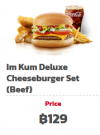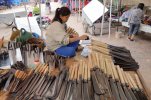- Joined
- Jan 6, 2016
- Messages
- 1,012
The BladeForums.com 2024 Traditional Knife is ready to order! See this thread for details:
https://www.bladeforums.com/threads/bladeforums-2024-traditional-knife.2003187/
Price is $300 $250 ea (shipped within CONUS). If you live outside the US, I will contact you after your order for extra shipping charges.
Order here: https://www.bladeforums.com/help/2024-traditional/ - Order as many as you like, we have plenty.
Depends on what you're stropping with. I use denim over a hard backing (wood) with aluminum oxide stick compounds (usually grey or white rouge) to quickly convex & polish bevels in steels like 420HC or 440A. Could also work on more wear-resistant steels like 440C, VG-10, even D2, using black compound on the same material. The denim allows very dense loading of the compound, which makes the strop work very aggressively, both to convex and to polish very quickly. The key is laying the blade LOW, so only the shoulders of the V-bevels are being worked, so the sharp edge doesn't get rounded off.Stropping doesn't remove nearly enough material to affect the shape of the entire cutting bevel.
All depends on pressure and compound , so you can strop possibly without removing significant material. The other material on that leading edge, unless the stropping surface has no give and is flat, Would comvex
Depends on what you're stropping with. I use denim over a hard backing (wood) with aluminum oxide stick compounds (usually grey or white rouge) to quickly convex & polish bevels in steels like 420HC or 440A. Could also work on more wear-resistant steels like 440C, VG-10, even D2, using black compound on the same material. The denim allows very dense loading of the compound, which makes the strop work very aggressively, both to convex and to polish very quickly. The key is laying the blade LOW, so only the shoulders of the V-bevels are being worked, so the sharp edge doesn't get rounded off.
With the grey or white stick compound heavily loaded on a hard-backed denim strop of 12" - 15" length, it takes maybe 10 minutes or less to convex & polish the bevels on a folder-sized blade in 420HC or 440A. Blades like traditional folders from Case or Buck up to folding hunter size, for example. Even fine-grade aluminum oxide is very aggressive on steels like these. I know this, because I've done it this way many times. It works very fast. It's not just about the grit size, but in the density to which the compound is loaded on the denim strop. And the very hard, firm backing to the denim makes it work even faster.Grey Rouge is around 1200 grit and White Rouge is in the 1-3 micron range, so 1500 grit at the coarse end. Basic geometry dictates that you can either keep the same ultimate edge location and knock down the shoulders where the cutting bevel meets the main bevel or keep the same shoulders (the points where the main bevel transitions into the cutting bevel) and create a convex bevel within the outline of the existing cutting bevel (this is the one that creates a substantial difference in thickness behind the edge). Either way, you have to remove a LOT of material to turn a straight bevel into a convex one, because you're essentially reprofiling. Even with aggressive abrasives, that's a lot of material to remove; at 1200+ grit, it'll take a long time. If that's the goal, you're probably better off just using wet/dry sandpaper instead of a strop.
In practice it is only as "good" as the final edge angle - an overstropped convex edge is a poor cutter compared to one that terminates with only a degree or two of widening. I prefer to do my convex edges on a hard stone most of the time for this very reason.
Yes. This is true if you apply a microbevel as well. It is possible to do both with only a couple of degrees total or per side, and that generally provides the best outcome.If you convex an existing triangular cutting bevel (not touching the main bevel of the knife), it will always end up with a more obtuse edge angle than it had before.


I rock my big Thai knives/machetes back and forth on a rock like these. Start at a low angle to get the rust off, then gradually increase as I get tired of it. They end up convex and sharp. No problem with the crooked, pot-holed stones. They smooth out eventually.
View attachment 1645872View attachment 1645874
The knife on the far left with the metal-banded sheath cost me about $5, 44 years ago. But it's a beautifully made Mien/Yao hilltribe knife. The one in the middle with the octagonal handle and deluxe blue plastic drainpipe sheath was about $2 many years later.Looks like typical Thailand workingman's gear! Nice thing about them is that it's all so inexpensive, both stones and knives. Knife wears out? Just stop at one of the bamboo stalls along the side of the road and have your pick from dozens of different sizes and shapes, all for the price of a McD's Happy Meal!
Stitchawl


My habitual tendency is to lay the blade just a hair lower in angle, each time I resharpen. This means most of the 'sharpening' is actually just thinning the grind a little more behind the edge, for the most part, with a minimum amount of work actually needed at the edge itself. And as the steel behind the edge gets thinner over time, it becomes that much less work to tune up the edge itself. So, one feeds the other, and it just keeps getting easier with time.Functionally speaking you don't have to worry about maintaining a perfect convex on knives with a convex primary grind. You'll just need to eventually thin the cheeks back out to preserve equally thin cutting geometry as it originally had. But that's technically true of all knives as you wear back into a conventional flat grind. One of the major appeals of hollow grinds is that it reduces the need for work of that kind.
This is correct to a certain extend, but in some cases, convexing is so minor that it can be ignored. For instance, if I want a noticeable convexed bevel, I use a regular 2-3mm thick leather strop. If I want micro convex in flat bevel then I use my 0.6-0.8mm kangaroo leather strop. I am stropping a scandi grind knife or if I try to avoid or minimise the convex on the bevel then I use my basswood strops.There us no doubt that convex knives are strongest behind the edge, simple due to more material and edge support. This is simply physics. That said, I learned this by owning a Bark River which come this way which I now love. What many do not realize is that if you stop a blade on leather, you always create a convex edge, so all my folders become convex at least on the edge and are usually mirror finished by the time I am done. Most manufactures do not create convex edges as it requires more skill and time and most sharpeners do not create this type of edge as their sharpening surface us hard or designed to grind material sharp fast. I think if we, the market, asked and looked for this, the makers and manufactirers would follow, Knife sharpening conpanies would create more tools oriented to this tipe of blade or final edge and the world would be a better place. Blades would stay sharper longer.
